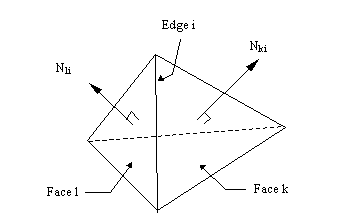CTETRA Element Checks and Default Bound Values |

|

|

|

|
|
CTETRA Element Checks and Default Bound Values |

|

|

|

|
CTETRA 1st-order (4-noded) Element Checks
The following qualities of the CTETRA 1st-order element are checked:
| • | Aspect Ratio |
The aspect ratio of a CTETRA 1st-order element is defined as the maximum of the aspect ratio of its four triangular faces. Each face is treated as a CTRIA3 element.
| • | Face Skew Angle |
The face skew angle of a CTETRA 1st-order element is defined as the maximum of the skew angles of its four triangular faces. Each face is treated as a CTRIA3 element.
| • | Vertex Angle |
The same vertex angle check is performed for all of the faces, and each is treated as a triangular (CTRIA3) or quadrilateral (CQUAD4) element. The minimum and maximum values reported for the element.
| • | Collapse |
The collapse of a CTETRA 1st-order element is defined as the minimum of four values, each calculated as the ratio between the distance from a vertex to its opposing face, and the square root of the area of the opposing face.
collapse = MIN (hi / sqrt(Ai) i = 1,2,3,4
The reported value is normalized by 1.2408, which gives the equilateral tetra a collapse value of 1. As the tetra collapses, the collapse value approaches 0.
| • | Edge Angle |
An edge angle is the absolute value of the angle between two faces sharing a common edge subtracted from 90 degrees. The edge angle (EA) of a CTETRA 1st-order element is defined as the maximum of its six edge angles.
EA = MAX | 90 - ANGLE(Nki, Nli) i = 1, ..., 6
Where, Nki and Nli are the normal vectors of faces k and l that have a common edge i.

CTETRA 2nd-order (10-noded) Element Checks
The following qualities of the CTETRA 2nd-order element are checked:
| • | Aspect Ratio |
This quality is calculated using only the corner nodes. Its definition is the same as that used for the CTETRA 1st-order element.
| • | Face Skew Angle |
This quality is calculated using only the corner nodes. Its definition is the same as that used for the CTETRA 1st-order element.
| • | Vertex Angle |
This quality is calculated using only the corner nodes. Its definition is the same as that used for the CTETRA 1st-order element.
| • | Collapse |
This quality is calculated using only the corner nodes. Its definition is the same as that used for the CTETRA 1st-order element.
| • | Edge Angle |
This quality is calculated using only the corner nodes. Its definition is the same as that used for the CTETRA 1st-order element.
| • | Hoe Normal Offset |
The hoe normal and tangent offsets of the CTETRA 2nd-order element are defined as the maximum of the hoe normal and tangent offsets of its 6 edges, respectively. See the definition of hoe normal offset of 3-node edge.
| • | Hoe Tangent Offset |
The hoe normal and tangent offsets of the CTETRA 2nd-order element are defined as the maximum of the hoe normal and tangent offsets of its 6 edges, respectively. See definition of hoe tangent offset of 3-node edge.
CTETRA Default Bounds
Information |
Default values for |
Default values for |
Default values for |
|||
|---|---|---|---|---|---|---|
Lower Limit |
Upper Limit |
Lower Limit |
Upper Limit |
Lower Limit |
Upper Limit |
|
Aspect Ratio |
- |
100.0 |
- |
1000.0 |
- |
1.0E5 |
Face Skew Angle |
- |
75.0 |
- |
85.0 |
- |
90.0 |
Collapse |
0.001 |
100.0 |
0.0 |
100.0 |
0.0 |
1000.0 |
Edge Angle |
- |
75.0 |
- |
87.0 |
- |
90.0 |
Hoe Normal Offset |
- |
0.30 |
- |
0.60 |
- |
1.0E5 |
Hoe Tangent Offset |
- |
0.20 |
- |
0.25 |
- |
0.50 |
The values used for warning and error checks may be adjusted by the ELEMQUAL bulk data entry, but validity checks are hard-coded.
See Also: